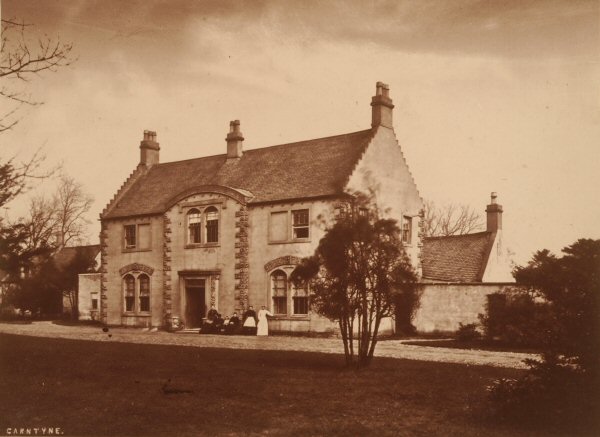

THIS edifice is about three miles eastward from Glasgow, via Eastern Duke Street and the highway to Shettleston. It was built in 1802 by Robert Gray of Carntyne, and he resided there till his death, embracing about thirty years. He was descended from a very old Glasgow family - the Grays of Carntyne and Dalmarnock - his ancestors having been proprietors of these estates several hundred years. He was a Deputy-Lieutenant for Lanarkshire, and an active Magistrate.
The Carntyne estate has long been celebrated for its almost inexhaustible seams of coal. These have been wrought by the Grays, from generation to generation, since about the year 1600, and still continue productive. The Carntyne, or better known as "The Westmuir," Coalpits long afforded one of the chief sources of fuel-supply to Glasgow. In olden time, when people sought to illustrate profundity, they used to cite a then common expression - "As deep as Carntyne Heugh." The first steam engine used in the West of Scotland for draining water from coal mines was erected at Carntyne. This was in 1768. It was very large and powerful, and continued in use till only recently. Previous to its erection, the water was for some time drawn off by the agency of a windmill, which performed the duty a number of years, till it was blown to pieces in a great storm, long popularly described as "the Windy Saturday."
Mr. Robert Gray died in 1833, and was succeeded in the Carntyne estate by his only son, the Rev. John Hamilton Gray. This gentleman was thirty-three years vicar of Bolsover and Scarcliffe in Derbyshire; twenty years rural dean of Chesterfield; and afterwards rector of Walton-le-Wold. He was a celebrated genealogist, and an accomplished scholar. His lady, also of an ancient Scotch family, holds a high place in literary circles as authoress of "A History of the Roman Emperors," "A Tour to the Sepulchres of Etruria," and other distinguished works. The reverend gentleman died in London, April 1867, and lies buried with his ancestors in the crypt of Glasgow Cathedral. With him the male line of the Grays of Carntyne terminated.
(1878)
The Grays have owned Carntyne for about 300 years. They owned Tollcross before that. And they owned Dalmarnock (which see) from 1678 to 1784. The last proprietor, the Rev. John Hamilton Gray of Carntyne, a member of the Scotch Bar, a vicar of the English Church, and a Deputy-Lieutenant of Lanarkshire, by his wife, Elizabeth Johnstone of Alva, left one daughter Caroline, now of Carntyne, the wife of John Anstruther Thomson of Charlton, Fife.
Carntyne Heugh has sent up its last hutch. The present proprietrix was the eighth successive owner who had worked the coal. But in 1875 the colliery was finally abandoned, partly from the increase of water, partly from the increase of feuing.
Back to Contents